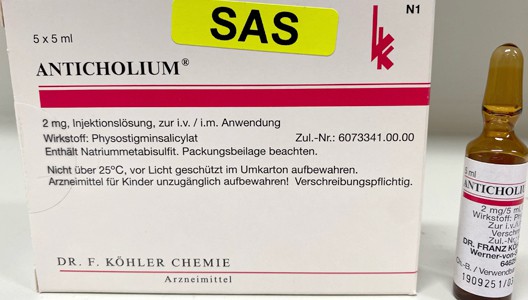Presentation
2mg in 5mL ampoule
SAS
Role
- Management of anticholinergic delirium.
- Diagnostic aid in suspected anticholinergic delirium.

If more than 4mg of physostigmine is required in a 24-hour period contact a Clinical Toxicologist for advice via a local toxicology service or the Poisons Information Centre on 13 11 26.
Dose
- 400 – 800 micrograms (child 20 micrograms/kg up to 400 micrograms) IV bolus over 10 seconds, followed 400 micrograms q10min PRN.
- A response should be seen by 2mg, if not seek alternative diagnoses.
- Repeat dosing after 60 minutes is commonly required to treat recurrence of delirium due to physostigmine’s short half-life.
Stocking recommendations
| Tertiary centre | Regional centre | Rural centre | Remote centre |
|---|---|---|---|
| 10 ampoules | 5 ampoules | 0-5 ampoules | 0 ampoules |
Rationale
Physostigmine is a safe and effective antidote for anticholinergic delirium that can avoid the need for sedation for behavioural control. It does not shorten the duration of delirium.
Precaution
- Avoid in patients with:
- asthma/chronic obstructive pulmonary disease
- cardiovascular disease
- peripheral vascular disease
- bradycardia.
- Excessive amounts of physostigmine causes predictable cholinergic toxicity.
- Patients receiving physostigmine should be cardiac monitored.
- Rarely, physostigmine use can be associated with seizures, these are typically self-resolving and short-lived, but if they occur, further doses should not be given.
Disclaimer
Fact sheet developed by Queensland Poisons Information Centre.
This fact sheet is about the use of these antidotes in Australia, and may not apply to other countries. Children’s Health Queensland Hospital and Health Service cannot be held responsible for the accuracy of information, omissions of information, or any actions that may be taken as a consequence of reading this fact sheet.